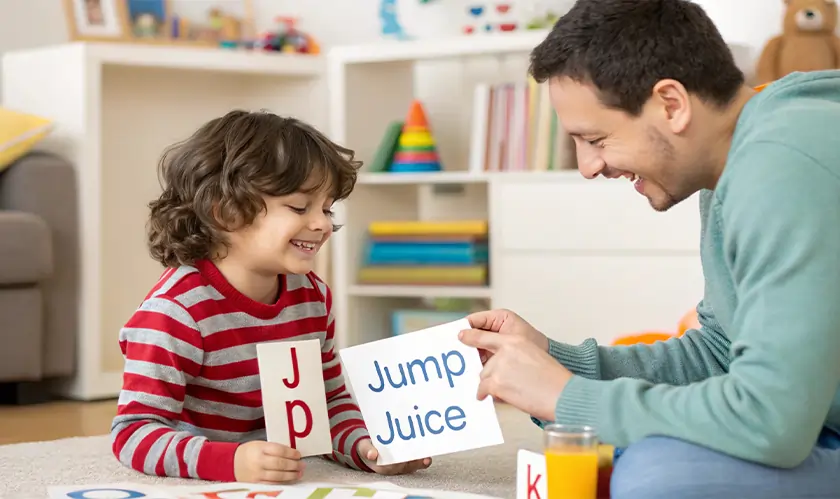Home Technology Medical technology How Can You Help Your Child Sa...
Medical Technology

CIO Bulletin
27 May, 2025
Many parents wonder how they can best support their child in saying J words clearly. By understanding the common challenges and using simple, targeted techniques, families can make a real difference in their child’s speech clarity. Small, daily practice sessions made for helping kids with J articulation can build confidence and noticeable results over time. Some of the most effective strategies include slowing down speech, using visual cues, and turning practice into fun games or activities.
This content should not be used as a substitute for direct medical advice from your doctor or other qualified clinicians.
Key Takeaways
Key Strategies to Help Your Child Say J Words Clearly
Children may struggle with J words because the sound uses specific tongue placement and movement. Speech therapy uses targeted activities and cues so kids can learn the correct sound and avoid common articulation errors.
Understanding Common Articulation Challenges
Children with an articulation disorder may substitute the J sound with other sounds like "d", "zh" (as in "measure"), or even "y". The J sound, written as /ʤ/, relies on raising the tip of the tongue to the ridge just behind the upper teeth, with the sides of the tongue touching the upper molars.
Mistakes often occur because children have difficulty coordinating their articulators or are not aware of the placement required for correct speech production. Errors can be more frequent in longer multisyllabic words or in the middle of phrases and sentences. Understanding these challenges is the first step to providing appropriate support.
Effective Speech Therapy Techniques
Speech therapy often begins with helping the child isolate the J sound before moving on to words, phrases, and sentences. Therapists may use visual cues, auditory models, and tactile feedback, such as having the child feel the vibration at the front of their mouth when saying "j".
Shaping techniques can be helpful; for instance, one method is starting from the "ee" sound combined with "sh" to gradually form the correct J sound. Repeated practice with words and structured activities supports motor planning and improves clarity. Parents are encouraged to work on articulation and speech clarity at home alongside professional sessions.
Using Flashcards and Multisyllabic Word Activities
Flashcards are effective tools for practising J words in various contexts and positions within a word. Cards can be organized by initial, medial, or final J sounds to target different difficulties. Start with single-syllable words and gradually move to multisyllabic word flashcards as the child progresses.
Therapists and parents can structure short activities, such as matching games, repetition drills, and word chains. These activities build practice in a fun, engaging way and support generalization from single words to phrases and full sentences.
Tools, Activities, and Further Resources for J Sound Practice
Effective practice of the /j/ sound can be supported with purpose-built speech therapy tools, interactive games, and tailored approaches for children with apraxia. Families and professionals benefit from combining digital resources, hands-on activities, and evidence-based strategies.
Utilizing Apps and Digital Resources
Many families find free apps for speech therapy that feature engaging visuals and voice playback helpful for reinforcing progress between therapy sessions. Digital platforms can track repetitions and offer immediate feedback, allowing progress to be monitored efficiently without special equipment.
Client-centred products tailored for speech sound work are available online, and many therapists recommend these as supplements. Screens should be used in moderation; combining app-based practice with real-world conversation is most effective for generalizing the J sound.
Fun Games Like Articulation Hunt
Games transform practice into fun, memorable experiences. Articulation Hunt is a straightforward activity where children search for objects or cards that begin with the J sound in a room. This game encourages attention to sound placement in natural settings.
Special events like Talk Like a Pirate Day can inspire themed practice sessions, making sound work more engaging. Including siblings or peers can turn drills into group challenges, helping children hear and produce the J sound in various contexts while keeping motivation high.
Supporting Children With Apraxia
Children with apraxia may require a different approach to J sound practice. They often benefit from multi-sensory cues, such as watching mouth movements in a mirror or feeling the buzz in their throat, as highlighted in expert advice on teaching the J sound.
Therapists recommend breaking words into syllables and slowing the pace to allow more processing time. Consistent drills and repeating simple J words, like "jeep" or "jam," with supportive feedback, build confidence and accuracy.
Caregivers should focus on positive reinforcement and patience. Regular consultation with a speech-language pathologist ensures that techniques are matched to the child’s unique needs, especially when motor planning is a challenge.
Conclusion
Supporting a child's ability to say J words clearly requires patience, regular practice, and targeted activities. Breaking words into simple sounds, using games, and incorporating repetition can make a noticeable difference.
Encouraging slow speech and shorter sentences helps children focus on correct pronunciation. Using positive feedback motivates improvement and keeps young learners engaged. Parents, caregivers, and educators play a key role. With consistency and a variety of fun strategies, most children can develop clearer speech when practising J words.







